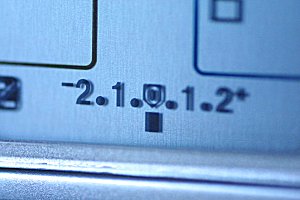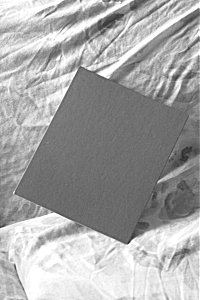Exposure Compensation with any Camera
Exposure can be compensated with virtually any camera. But the camera operator has to know which type of camera is being used. The easiest way, of course, is to get a camera with built-in exposure compensation feature. But that is no fun for us, hackers. Following are the techniques used for each type of camera without the exposure compensation feature.
Auto-Exposure

Auto-exposure cameras have a fixed-focus lens or manual focus lens. These cameras are the easiest to set exposure. To obtain the correct exposure for your subject, simply lock the exposure (by pressing the shutter down halfway on most cameras) on a reference object that is 18% gray and that is lit by the same source as your subject. An 18% gray card is most useful in this case. To under-expose, find a reference that is lit by the same source as the subject and is lighter than 18% gray. Find a darker reference object to over-expose. After locking exposure, the operator recomposes the frame and shoots.
Auto-Exposure and Auto-Focus
Auto-exposure and auto-focus cameras are slightly harder to set exposure, because exposure-lock is generally tied to focus-lock. Nevertheless, one can still get the correct exposure and correct focus using these cameras. Exposure can be adjusted by locking on an 18% reference that is lit by the same source as the subject. Just make sure that the distance to the reference is the same as the distance to the subject, which will set the focus. The operator can easily do this by moving forward and backward. The techniques for under and over-exposure works the same way as previously described.

As an example, this technique worked exceptionally well with the Sony DSC-U30 digital camera. This camera did not have the exposure compensation feature. I had to shoot a room with white walls this past weekend. If I had locked exposure on the white walls, my shots would have been under-exposed to 18% gray. And 18% gray is not white. Therefore I locked exposure on the uncovered bed (close to 18% gray) in the room, made sure the bed was as far away as the wall, and shot the picture. To shoot the lamp in the room, I had to lock exposure on a dark garbage bag to compensate by +2 stops. I was able to see the shots right away on the digital camera. But if a film camera is used, the operator may want to bracket the exposures by locking on reference objects of different shades.
Fixed-Exposure
As the name implies, exposure cannot be adjusted on a fixed-exposure camera. Most disposable cameras fall under this category. One way to compensate exposure with these cameras is to use available lighting, such as electronic flash. But that is another article all by itself, because we will have to talk about exposure compensation for electronic flashes.
Related Links
- Accurate Exposure with Your Meter - Kodak Technical Data Reference
- Nikon Web Magazine: Creating better pictures: Exposure Compensation
- Understanding Exposure: How to Shoot Great Photographs With a Film or Digital Camera - Amazon User Reviews
- using exposure compensation
594 Users Online

$10000-above $5000-$9999 $2000-$4999 $1000-$1999 $500-$999 $200-$499 $100-$199 $50-$99 $25-$49 $0-$24 Gift Certificate |
|


